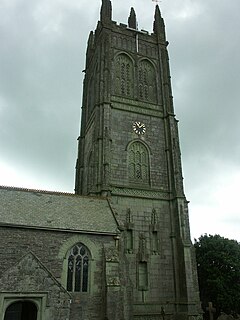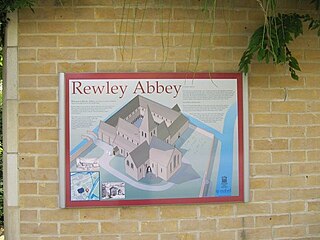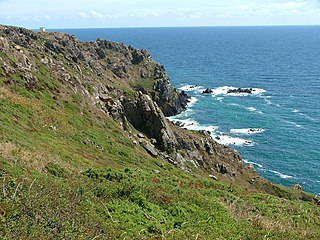Related Research Articles

Hailes Abbey is a former Cistercian abbey, in the small village of Hailes, two miles northeast of Winchcombe, Gloucestershire, England. It was founded in 1246 as a daughter establishment of Beaulieu Abbey. The abbey was dissolved by Henry VIII in 1539. Little remains of the abbey. It is a Grade I listed building and a scheduled monument.

Netley Abbey is a ruined late medieval monastery in the village of Netley near Southampton in Hampshire, England. The abbey was founded in 1239 as a house for monks of the austere Cistercian order. Despite royal patronage, Netley was never rich, produced no influential scholars nor churchmen, and its nearly 300-year history was quiet. The monks were best known to their neighbours for the generous hospitality they offered to travellers on land and sea.

St Keverne is a civil parish and village on The Lizard in Cornwall, England, United Kingdom.

Beaulieu Abbey, grid reference SU389026, was a Cistercian abbey in Hampshire, England. It was founded in 1203–1204 by King John and populated by 30 monks sent from the abbey of Cîteaux in France, the mother house of the Cistercian order. The Medieval Latin name of the monastery was Bellus Locus Regis or monasterium Belli loci Regis. Other spellings of the English name which occur historically are Bewley and Beaulie.
The Abbey of Arrouaise[ɑʁ.wɛz] in northern France was the centre of a form of the canonical life known as the Arrouaisian Order, which was popular among the founders of canonries during the decade of the 1130s. The community began to develop when Heldemar joined the hermit Ruggerius in 1090 and approved by the local bishop in 1097. The priory was raised to the status of an abbey in 1121, electing as its first abbot, Gervaise. He impressed people who had the wealth and secular power, sufficient to found an abbey, which they did.

Great Coxwell Barn is a Mediæval tithe barn at Great Coxwell, Oxfordshire, England. It is on the northern edge of the village of Great Coxwell, which is about 9 miles (14 km) northeast of Swindon in neighbouring Wiltshire.

Manaccan is a civil parish and village on the Lizard peninsula in south Cornwall, England, United Kingdom. The village is about five miles (8 km) south-southwest of Falmouth.

Probus is a civil parish and village in Cornwall, England, in the United Kingdom. It has the tallest church tower in Cornwall. The tower is 129 feet (39 m) high, and richly decorated with carvings. The place name originates from the church's dedication to Saint Probus. The parish population at the 2011 census was 2,299, whereas the ward population taken at the same census was 3,953.

Grade–Ruan is a civil parish on the Lizard peninsula in Cornwall, England, United Kingdom, approximately ten miles (16 km) south of Falmouth.

Llanllugan Abbey was a monastery of Cistercian nuns, one of only two Cistercian women's monasteries in Wales, located at Llanllugan, Powys, Wales. An early charter to Llanllugan nunnery was issued by Maredudd ap Rhobert, Lord of Cedewain, probably some time in the early thirteenth century. Maredudd's charter provided the nuns with their core estates in the township of Llanllugan between the two streams of the Rhiw. The abbey's other estates include Hydan grange in Castle Caereinion and Cowney in Llangadfan. Llanllugan also received income from appropriated churches, the rectory of Llanfair Caereinion was granted by Bishop Hugh of St Asaph in 1239 and Llanllwchairan by Bishop Anian of St Asaph in 1263. It was founded as a dependency of the Cistercian monks at the Abbey of Strata Marcella. The former monastery church survives as the parish church of Llanllugan. However, the site of the abbey buildings remains uncertain: they might have been in a meadow 200 metres to the south of the church.

The Cistercian Abbey of Rewley was an Abbey in Oxford, England. It was founded in the 13th century by Edmund, 2nd Earl of Cornwall. Edmund's father, Richard, 1st Earl of Cornwall, founder of Hailes Abbey, had intended to establish a college or chantry of three secular priests to pray for his soul, but his son Edmund substituted 'six Cistercian monks, having more confidence in them.' If this was the original plan, it was soon enlarged. In 1280 he offered the general chapter of the Cistercian order to found a college (studium) for Cistercians at Oxford, and the chapter accepted the offer, and decreed that the college should have the same privileges as the college of St. Bernard at Paris, and that it should be under the Abbot of Thame, as the other was under the Abbot of Clairvaux. The following year the chapter decreed 'out of due respect to the Earl of Cornwall' that the Abbot of Thame should be empowered to appoint an Abbot of his own choice for the house of study at Oxford, and that there should be a daily memory of the late Earl of Cornwall at Mass at the college (studium) of Oxford, according as the Abbot of the place shall ordain.

Laddenvean is a small settlement in southwest Cornwall, England, United Kingdom. It lies immediately north of, and adjoins, St Keverne village 7 miles (11 km) south of Falmouth.

The Meneage is a district in west Cornwall, United Kingdom. The nearest large towns are Falmouth and Penryn.

Cardinham Grange was a monastic grange in Cardinham, Cornwall, UK. Lady Vale Chapel was given soon after the Norman Conquest by Richard Fitz Turold to the Abbey of St Mary de Valle near Bayeux intending that a cell of monks should be established. The abbey, finding the property burdensome, induced Richard to transfer it to the monastery of Tywardreath which he was then founding. It was served by monks from Tywardreath until the dissolution of the monasteries when the property was granted to the Duchy of Cornwall.
Faringdon Abbey was a Cistercian abbey located at Wyke just north of the small town of Faringdon in the English county of Berkshire.

Kennack to Coverack is a coastal Site of Special Scientific Interest (SSSI) on the Lizard Peninsula in Cornwall, England, UK, noted for both its biological and geological interest. It is of botanical importance, with 8 Red Data Book of rare and endangered plant species being found on the site as well as other nationally scarce varieties.

Grace Dieu Abbey was a small Cistercian abbey established in 1226 near to the town of Monmouth in south east Wales. No remains of its buildings can now be seen above ground. It was originally located on the west bank of the River Trothy, in remote countryside about 2 miles (3.2 km) north of the village of Dingestow, but relocated on at least one occasion after being attacked by the Welsh. Its final site is uncertain, but investigations have focused on a field on the east side of the Trothy, at grid reference SO45121311, and this is the location labeled on OS maps.
References
- ↑ "Tregonan Grange". PastScape. English Heritage. Retrieved 4 February 2011.
- ↑ Cornish Church Guide (1925) Truro: Blackford; pp. 117-18
Coordinates: 50°03′08″N5°05′25″W / 50.052183°N 5.090141°W